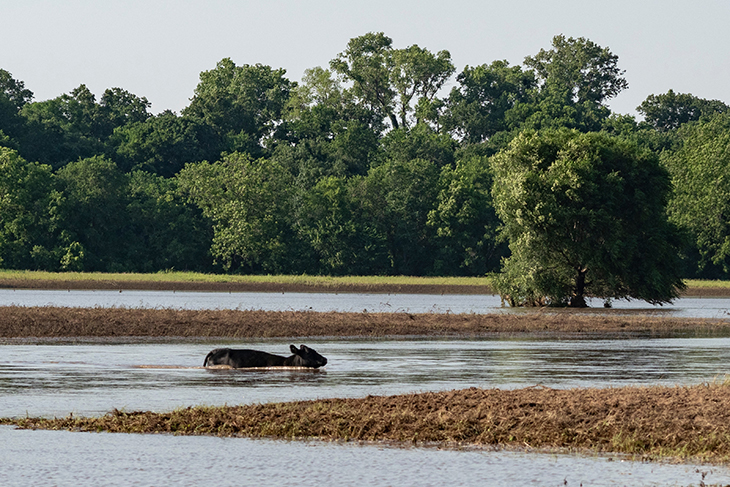
Deadline looming for commercial livestock producers to file with FSA
Monday, June 17, 2019
Commercial livestock producers whose animals died as a direct result of recent historic flooding must notify Farm Service Agency within 30 days of the death of the livestock to qualify for potential assistance under the Livestock Indemnity Program.
“Producers who qualify for the program should contact their FSA office immediately, as time is short for many of them,” said Trent Milacek, Oklahoma State University Cooperative Extension area agricultural economist. “Also, be aware an application for payment must be filed within 60 days after the end of the calendar year in which the losses occur.”
LIP covers livestock mortality that falls outside or normal parameters, such as natural disasters and other storm damage. This coverage is limited to commercial livestock with documentation of death. LIP is administered by FSA, part of the U.S Department of Agriculture.
“Payments to qualifying owners are based on national rates that are 75 percent of the market value of the applicable livestock as determined by USDA,” Milacek said.
To be eligible for LIP, a livestock producer must have legally owned the animals on the day they died or were injured by an eligible loss condition. The applicable livestock must have either died in excess of normal mortality as a direct result of the eligible loss condition, or been injured as a direct result of an eligible loss condition and were sold at a reduced price.
Eligible livestock must have been maintained for commercial use as part of a farming or ranching operation on the day they died, and not have been produced or maintained for reasons other than commercial use.
“Excluded livestock include wild, free-roaming animals, pets or animals used for recreational purposes such as hunting, roping or for show,” said Rusty Humphrey, FSA executive director for Kay County. “Even if you’re unsure whether or not you qualify, contact your FSA county office. We’ll talk you through the process and if you qualify, help get you going in the right direction.”
For contract growers, poultry and swine are the only livestock eligible under LIP rules. In addition to meeting all other eligibility requirements for loss, a contract grower also must have had possession and control of the applicable livestock, and a written agreement with the eligible livestock owner setting the specific terms, conditions and obligations of the parties involved regarding the production of livestock.
“Contract growers are not eligible for losses under LIP for injured livestock that were sold at a reduced price due to an eligible loss condition,” Humphrey said. “Be aware payments for LIP will be reduced by any amount received by the participant for the same or any similar loss from a different source.”
Livestock and contract growers must record all pertinent information – including the number and kind – of all livestock and those adversely affected by an eligible loss condition. The easiest and most generally accepted proof of death loss is photographic documentation.
“Independent, third-party verification is always a good idea but one that too many producers fail to consider when they’re in the midst of a natural disaster such as a flood,” Milacek said. “It’s why we’re always recommending producers call their OSU Cooperative Extension county office at first opportunity. Our county agricultural educators will make every effort to come out and provide that independent verification, and probably share other useful information based on an operation’s specific needs as well.”
Livestock producers seeking additional information about potential flood recovery and relief should contact their OSU Cooperative Extension county office, typically listed in local directories under “County Government.”
The Oklahoma Cooperative Extension Service is one of two state agencies administered by the OSU Division of Agricultural Sciences and Natural Resources, and is a key part of the university’s state and federally mandated teaching, research and Extension land-grant mission.
MEDIA CONTACT: Donald Stotts | Agricultural Communications Services | 405-744-4079 | donald.stotts@okstate.edu
